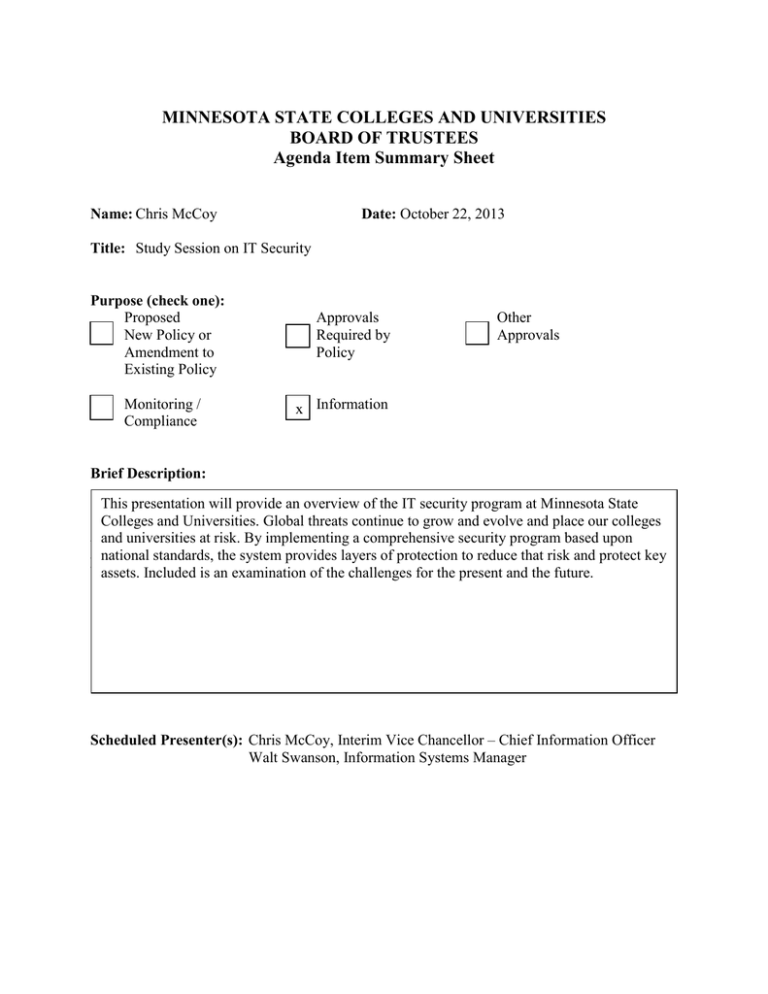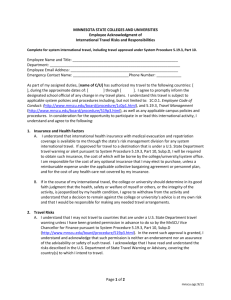MINNESOTA STATE COLLEGES AND UNIVERSITIES BOARD OF TRUSTEES Agenda Item Summary Sheet
advertisement

MINNESOTA STATE COLLEGES AND UNIVERSITIES
BOARD OF TRUSTEES
Agenda Item Summary Sheet
Name: Chris McCoy
Date: October 22, 2013
Title: Study Session on IT Security
Purpose (check one):
Proposed
New Policy or
Amendment to
Existing Policy
Monitoring /
Compliance
Approvals
Required by
Policy
Other
Approvals
x Information
Brief Description:
This presentation will provide an overview of the IT security program at Minnesota State
Colleges
andfrom
Universities.
Global
continue
and evolve
place
colleges
[Type
a quote
the document
orthreats
the summary
of to
angrow
interesting
point.and
You
can our
position
the
and
universities
at
risk.
By
implementing
a
comprehensive
security
program
based
upon
text box anywhere in the document. Use the Drawing Tools tab to change the formatting of the
national
pull
quote standards,
text box.] the system provides layers of protection to reduce that risk and protect key
assets. Included is an examination of the challenges for the present and the future.
Scheduled Presenter(s): Chris McCoy, Interim Vice Chancellor – Chief Information Officer
Walt Swanson, Information Systems Manager
Board of Trustees
Study Session on IT Security
October 22, 2013
Chris A. McCoy
Interim Vice Chancellor for Information
Technology
Walt Swanson
Information Security Officer
The Minnesota State Colleges and Universities system is an Equal Opportunity employer and educator.
Outline
Global and MnSCU Security Facts
The MnSCU Security Program
Continuous Assessment of Protection
A Challenging Future
Questions for Discussion
2
Global Security Facts
Worldwide, estimated 1 billion cyber attacks annually
Estimated that 1 out of every 3 computers in the U.S. is
infected with malware
556 million victims per year, 1.5+ million per day, 18 per second
More than 232.4 million identities exposed annually
99+% are preventable
More than 600,000 Facebook accounts compromised DAILY
Kaspersky Labs reports the detection of 200,000 unique
malicious programs DAILY
McAfee to date has archived 147 million unique samples of
malware, growing at a rate of over 18.5 million per year
3
Global Security Facts
Nationally, 315 database breaches reported in 2012
An average of 604,826 identities exposed PER BREACH
Top five database breaches among Higher Ed in 2012
University of Nebraska: 654,000 (identities exposed)
Indiana University: 650,000
University of North Carolina: 350,000
Arizona State University: 300,000
Northwest Florida State College: 279,000
Average cost per record breached (Higher Ed) is $142
4
Global Security Facts
Nationally, 59% of ex-employees admit to stealing company data
from previous employer
Among network threats nationally in 2012, 73% are browser-related
3.5 million web pages worldwide are estimated to contain malware
Motivation for malicious activity:
40% Cyber crime
50% Hactivisim
3% Cyber Warfare
7% Cyber espionage
In 2009, President Obama estimated that the annual cost of cyber
security may be as high as $1 trillion
5
MnSCU Security Facts
1.2 million business transactions processed MONTHLY
4.3 billion records in ISRS; 1.5 billion records in D2L
Peak load is 59,000 statements PER SECOND
~45,000 desktops, laptops, and servers systemwide
The system collects log data from network and server activity
enough to fill 13 million pages of a typical novel DAILY
Out of 100 emails, 15 are delivered and 85 are rejected as SPAM
Network firewalls reject 35 million connections DAILY
80,000 security conditions checked per system MONTHLY
More than 25 million security updates applied ANNUALLY
Across the system, we are spending over $3 million ANNUALLY
6
What is at risk for our
Colleges and Universities?
Privacy of student transcripts as required by FERPA
Privacy of our student and employee identities
Privacy of health records as required by HIPAA
Confidentiality of our communications (phone and email)
Safe operation of building services – HVAC, security cameras,
parking systems, secure building access, etc.
Financial transactions, bank accounts, wire transfers
Reputation
7
Focus on Protecting Key Assets
Private data on students and employees
Financial transactions
Intellectual property
Continuity of operations
Disruption of service
Harm to building systems
8
The MnSCU Security Model
Mission
Support Minnesota State Colleges and Universities strategic directions
by protecting information resources against unauthorized use,
disclosure, modification, damage or loss.
Goals
Protect the confidentiality, integrity and availability of information
resources through leadership, strategies, and services.
Identify information security risks, the appropriate safeguards to
address them, and intervene to manage risk.
Promote information security practices through education, training,
testing and assessment.
9
The MnSCU Security Model
{Refer to handout}
Stat
Minnesota
e
rity Progra
ation Secu
ties Inform
d Universi
an
s
ge
lle
Co
Security Lif
k Ma
Security Ris
Leadership
nce
&Governa
Assess and
Evaluate
and
Leadership
Governance
sion
Mis
and
e Colleges
nesota Stat
ctions by
Support Min
inst
strategic dire
Universities rmation resources aga tion,
info
modifica
re,
protecting
losu
d use, disc
unauthorize
loss.
damage or
Functions:
ysis &
· Risk Anal
Assessment
Functions:
ce
· Governan
edures &
· Policy, Proc
Guidelines
ce &
· Complian
Metrics
s in this area
Safeguard
address:
s in this area
Safeguard
address:
als
Go
grity
ntiality, inte
the confide
rmation
· Protect
ility of info
and availab
ership,
through lead
.
resources
ices
serv
and
strategies,
s, the
security risk
information
to address
· Identify
safeguards
.
appropriate rvene to manage risk
inte
and
,
them
tices
security prac and
information
testing
ing
· Promote
train
cation,
through edu
t.
assessmen
nt’s
· Manageme t &
commitmenfor
leadership security
information oversight
and
· Direction
initiatives
of security
d&
mente
Docu
·
Policy,
sanctioned
& Guidelines
Procedures
ction of
for the prote
private data tecture
· Secure Archi
of
· Validation d controls/
implemente based on
safeguards
,
MnSCU Policy
& Guidelines
Proceduresof compliance
· Validation atory
with regul ts – i.e.
requiremen
A, PCI
ss
MGDPA, FERP
effectiveneols
· Monitoring
d contr
of implemente
measure
· Metrics to ss of
effectivene d controls/
implemente
safeguards
controls
· Security
d, and
implementeies for
opportunit nt
improveme and
for,
· Planning future
structuring
initiatives
(PL)
· Planning
Mgmt. (PM)
· Program
· Audit & Accou
(AU)
10
ntability
m
ecycle
nagement
Personnel
Security,
&
Awareness
Education
Functions:
l Security
· Personne
&
· Awareness
Training
s in this area
Safeguard
address:
& awareness
· Training job
· Defined
ities that
responsibil ity
include secur
of duties
· Separation
Operate and
Maintain
Acquire and
Develop
Functions:
agement &
· Asset Man
rol
Access Cont
ction &
· System Prote
Integrity
Information
s and
· Operation
nce
Maintena
Functions:
lopment
· Secure Deve
nt
& Deployme
mation
· Include Infor
system
Security in
Procurement
Respond and
Recover
Functions:
very
· Disaster Reco
and Incident
Response
s in this area
Safeguard
address:
s in this area
Safeguard
address:
s in this area
Safeguard
address:
g practices
· Secure codin
nt training
· Developmetion
y
and educa
vulnerabilit
· Software ts – tools and
assessmen
process
procured or
in
ity
· Secur
systems
developed
fication,
· Asset idention &
classificati
ownership ification
· Data class measures
protection
access
· Remote
n and
· Authorizatioion
authenticatof
· Protection l assets
informationa tions or
during operae – i.e.
maintenanc
e
backups, chang
rability
control, vulne
n, patch
identificationt
manageme
for incidents/
· Planning disaster
events or n of
· Identificatio ents or
incidents/ev
disaster (Incident &
· Response
Disaster) of Operations
· Continuity& restoration
· Recovery
· Forensics
ents
10/16/2013
10/9/2013 ” Compon
3 “Family
NIST 800-5
t and
Assessmen
· Security
n (CA)
Authorizatio
sment (RA)
· Risk Asses
Security (PS)
· Personnel
& Training
· Awareness
(AT)
Servic
· System &
(SA)
Acquisition
es
n
· Configuratio (CM)
nt
Manageme
e (MA)
· Maintenanc tion (MP)
· Media Protec
Information
· System &
(SI)
ity
Integr
ol (AC)
· Access Contr &
n
· Identificatio
on (IA)
Authenticati
ion
Communicat
· System &
(SC)
Protection
Planning
· Contingency
(CP)
nse (IR)
· Incident Respo
Based on National Institute of
Standards and Technology
Special Publication 800-53,
“Recommended Security
Controls for Federal
Information Systems”
Continuous Assessment of Protection
Policy, Procedure,
Guideline
Incident Response,
Legal
Network, System,
Software, User
Controls
Logging, Monitoring,
Internal Audit
11
Continual testing
of systems and
intervention
throughout all
layers of security
Policy, Procedure,
Guideline
Incident Response, Legal
Network, System,
Software, User Controls
Policy, Procedure,
Guideline
Logging, Monitoring,
Internal Audit
Policy 5.23, Security and Privacy of Information Resources
Nine Supporting Guidelines:
Passwords
Incident Response
Data Sanitization
Encryption for Mobile
Computing
Patch Management
12
Anti-malware
Vulnerability Scanning
Data Backup
Payment Card Industry
Technical Requirements
Policy, Procedure,
Guideline
Incident Response, Legal
Network, System,
Software, User Controls
Network, System,
Software, User Controls
Logging, Monitoring,
Internal Audit
Network
Firewalls
Patch Management
Segmentation
Malware scanning
Vulnerability Management
System
13
Software
User
StarID
Data Centers
Passwords
Data Encryption
Roles
Database segmentation
Training and education
Policy, Procedure,
Guideline
Incident Response, Legal
Network, System,
Software, User Controls
Logging, Monitoring,
Internal Audit
Logging, Monitoring,
Internal Audit
Security Information and Event Management
Network activity
System/server activity
Database table auditing
Oracle Audit Vault (FY2013)
Internal Audit
14
Policy, Procedure,
Guideline
Incident Response, Legal
Network, System,
Software, User Controls
Incident Response, Legal
Logging, Monitoring,
Internal Audit
Data Recovery
Forensics
Legal
Minnesota Government Data Privacy Act (MGDPA)
Family Education Rights and Privacy Act (FERPA)
Health Insurance Portability and Accountability Act (HIPAA)
Payment Card Industry Data Security Standard (PCI DSS)
15
Growing and Evolving Threats
Growth of cloud for storage and services (data off-site)
Bring-Your-Own-Devices (BYOD) / Consumerization
35% of adults have lost or had their mobile devices stolen
65% of all mobile devices use NO security solutions
“Madware”
Malicious web
87% of all malicious activity on the internet is via malicious URLs
40% of Americans click on unsafe links
16
“Ransomware”
Advanced persistent threats / weaponized malware
Social engineering
Internal
System Challenges
Higher education continues to struggle with balance between
security and openness, transparency, and collaboration
Threats continue to evolve at an increasing pace
Tension between privacy and the use of analytics
Need to work with CIOs on clarification of responsibilities for
ensuring success
We’re all interconnected – the weakest link threatens all of us
and we must collaborate to ensure the integrity of our system
A centralized model will not work from St. Paul
17
Questions for Discussion
IT security is integral; it is not an add-on. How do we infuse
security into everything we do?
There are not enough resources in the world to perfectly
secure everything. Are we focused on the right priorities?
How should we balance the benefits of new and emerging
technologies (e.g. cloud and mobile) which allow for
innovation, exploration, and discovery with the risks?
18
